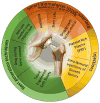Regenerative Medicine Strategies in Biomedical Implants
- PMID: 29679306
- PMCID: PMC6033057
- DOI: 10.1007/s11914-018-0441-0
Regenerative Medicine Strategies in Biomedical Implants
Abstract
Purpose of review: Recently, significant progress has been made in the research related to regenerative medicine. At the same time, biomedical implants in orthopedics and dentistry are facing many challenges and posing clinical concerns. The purpose of this chapter is to provide an overview of the clinical applications of current regenerative strategies to the fields of dentistry and orthopedic surgery. The main research question in this review is: What are the major advancement strategies in regenerative medicine that can be used for implant research?
Recent findings: The implant surfaces can be modified through patient-specific stem cells and plasma coatings, which may provide methods to improve osseointegration and sustainability of the implant. Overall understanding from the review suggesting that the outcome from the studies could lead to identify optimum solutions for many concerns in biomedical implants and even in drug developments as a long-term solution to orthopedic and dental patients.
Keywords: Biomedical implants; Regenerative medicine; Stem cells; Surface modifications.
Conflict of interest statement
Divya Bijukumar, Clay McGeehan and Mathew Mathew declare no conflict of interest.
Figures



Similar articles
-
Enhancing orthopedic implant bioactivity: refining the nanotopography.Nanomedicine (Lond). 2015;10(8):1327-41. doi: 10.2217/nnm.14.216. Nanomedicine (Lond). 2015. PMID: 25955126 Review.
-
Implants in bone: part I. A current overview about tissue response, surface modifications and future perspectives.Oral Maxillofac Surg. 2014 Sep;18(3):243-57. doi: 10.1007/s10006-013-0398-1. Epub 2013 Feb 24. Oral Maxillofac Surg. 2014. PMID: 23435578 Review.
-
Biological strategies for improved osseointegration and osteoinduction of porous metal orthopedic implants.Tissue Eng Part B Rev. 2015 Apr;21(2):218-30. doi: 10.1089/ten.TEB.2014.0333. Epub 2014 Dec 18. Tissue Eng Part B Rev. 2015. PMID: 25348836 Free PMC article. Review.
-
Conus hip prosthesis.Acta Chir Orthop Traumatol Cech. 2001;68(4):213-21. Acta Chir Orthop Traumatol Cech. 2001. PMID: 11706545
-
Osseointegrated Prosthetic Implants for People With Lower-Limb Amputation: A Health Technology Assessment.Ont Health Technol Assess Ser. 2019 Dec 12;19(7):1-126. eCollection 2019. Ont Health Technol Assess Ser. 2019. PMID: 31911825 Free PMC article.
Cited by
-
Therapeutic potential of mesenchymal stem cell-derived exosomes for regenerative medicine applications.Clin Exp Med. 2024 Mar 1;24(1):46. doi: 10.1007/s10238-023-01282-z. Clin Exp Med. 2024. PMID: 38427086 Free PMC article. Review.
-
Friction in soft biological systems and surface self-organization: the role of viscoelasticity.Biophys Rev. 2024 Oct 28;16(6):813-829. doi: 10.1007/s12551-024-01248-9. eCollection 2024 Dec. Biophys Rev. 2024. PMID: 39830128 Free PMC article. Review.
-
Dental and Orthopaedic Implant Loosening: Overlap in Gene Expression Regulation.Front Immunol. 2022 Feb 11;13:820843. doi: 10.3389/fimmu.2022.820843. eCollection 2022. Front Immunol. 2022. PMID: 35222398 Free PMC article.
-
The current regenerative medicine approaches of craniofacial diseases: A narrative review.Front Cell Dev Biol. 2023 Feb 28;11:1112378. doi: 10.3389/fcell.2023.1112378. eCollection 2023. Front Cell Dev Biol. 2023. PMID: 36926524 Free PMC article. Review.
-
Interface Performance Enhancement in 3D-Printed Biphasic Scaffolds with Interlocking Hourglass Geometry.Ann Biomed Eng. 2025 Jul 11. doi: 10.1007/s10439-025-03791-2. Online ahead of print. Ann Biomed Eng. 2025. PMID: 40646321
References
-
- Rankin EA. AJRR: becoming a national US joint registry. Orthopedics. 2013;36(3):175–176. - PubMed
-
- Wilson NA, Schneller ES, Montgomery K, Bozic KJ. Hip And Knee Implants: Current Trends And Policy Considerations. Health Aff (Millwood) 2008 Nov 1;27(6):1587–98. - PubMed
-
- Cushner F, Agnelli G, Fitzgerald G, Warwick D. Complications and functional outcomes after total hip arthroplasty and total knee arthroplasty: results from the Global Orthopaedic Registry (GLORY) 2010 - PubMed
-
- Products - Data Briefs - Number 197-May 2015 [Internet] [cited 2017 Dec 24]. Available from: https://www.cdc.gov/nchs/products/databriefs/db197.htm.
Publication types
MeSH terms
Substances
Grants and funding
LinkOut - more resources
Full Text Sources
Other Literature Sources
Medical
Research Materials

